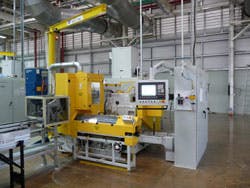Cost-Saving, Timesaving Double-Disc Grinder for Allison Transmission
Allison Transmission, which manufactures commercial-duty automatic transmissions and hybrid propulsion systems for truck and off-road vehicle manufacturers, ordered a new grinding cell from C&B Machinery. C&B develops and builds grinding systems for manufacturers around the world; in this case, it will build a “flexible” double-disc grinding cell for Allison Transmission India Private Ltd. in Chennai, India.
The new cell is designed to grind the faces of transmission pinion gears for Allison’s 1000 and 2000 series transmissions. Double disc grinders will remove an equal amount of material from both faces, simultaneously. This machine will be set up to grind four different pinion configurations, and capable of grinding 11 more configurations that are being produced at the plant already. (C&B Machinery also supplied the grinders already installed at the Chennai plant and producing those designs.)
The new machine performs a “rotary plunge” grinding cycle, which means the pinions are introduced to the grinding wheels via a rotary carrier, one at a time, while the grinding wheels plunge grind simultaneously through axis interpolation. There are several advantages for grinding in this manner, the most important of which is that the grinding wheels are adjusted perfectly parallel and concentric to each other. (Most often, conventional double-disc grinding requires compound head settings.) Keeping the wheels parallel results in more uniform wheel wear and reduced frequency of dress cycles, saving on the cost of abrasives. The cost per piece is reduced and the return on investment is faster.
This grinding cycle as developed by C&B Machinery engineers. In addition to the operating- and investment-cost savings it allows 100% gauge feedback on every component ground. Size control is tightened, resulting in higher statistical capability. For example, the grinding cells previously shipped by C&B far exceeded 2.0 ppk in OAL (± 0.030 mm) and parallelism (0.026 mm).
The entire grinding cell including the grinder, automation, gauging system, coolant system and even the production (bench) gages are supplied and integrated by C&B Machinery.
“Flexibility is a very strong requirement for customers today,” according to C&B Machinery’s vice president – Sales, Chris Cox. “In parallel, it is now one of the main selling features of C&B Machinery’s grinding systems, as well as our very company. These special grinding cells are designed to change over from part to part in as little as three minutes. Considering that production double-disc grinders have been historically dedicated machines, it is quite an about-face.
“The most important aspect of this project is to convey — on a global scale — that the American machine tool industry is still alive and well. We have the talent base and the ingenuity to compete globally and produce and support some of the highest quality and most flexible grinding systems available anywhere in the world,” Cox added.
